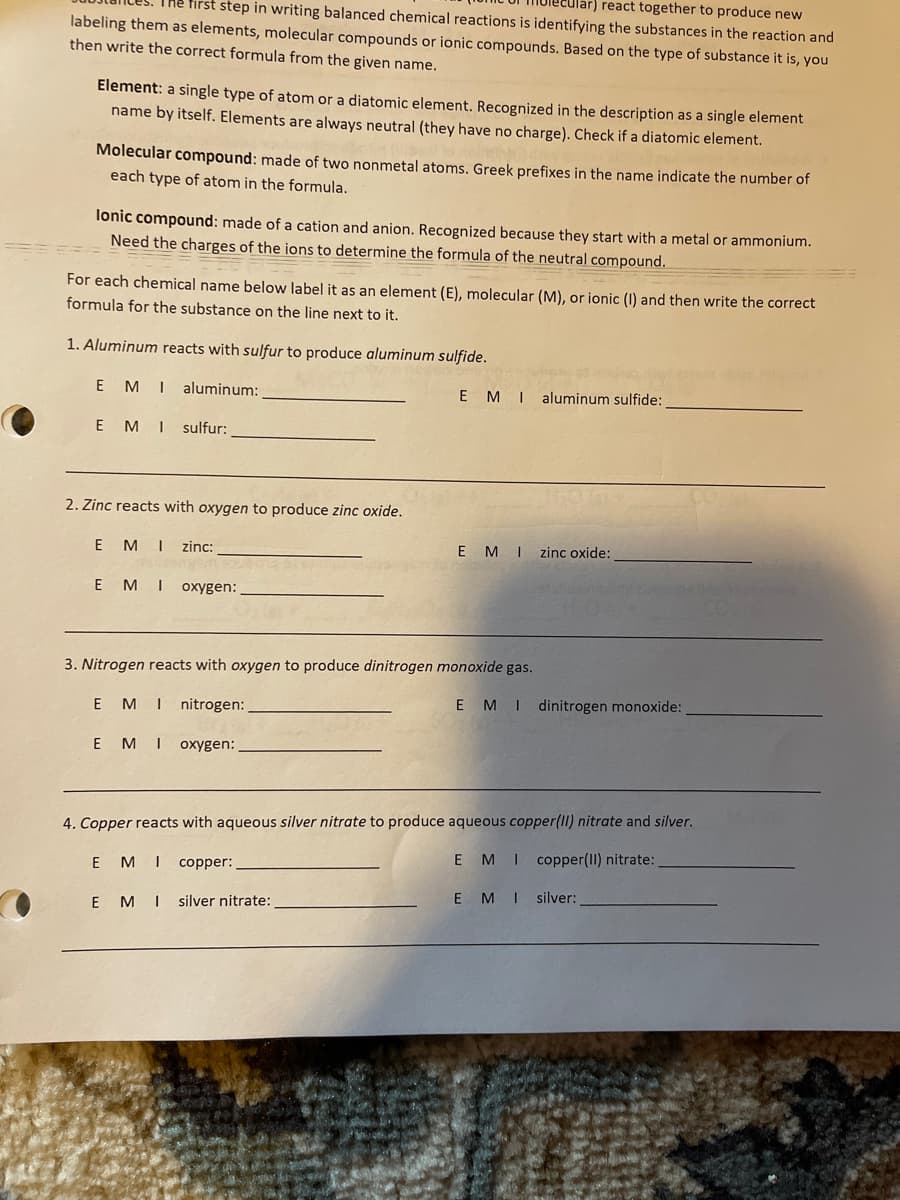For each chemical name below label it as an element (E), molecular (M), or ionic (1) and then write the correct formula for the substance on the line next to it. 1. Aluminum reacts with sulfur to produce aluminum sulfide. MI aluminum: MI sulfur: E E 2. Zinc reacts with oxygen to produce zinc oxide. E MI zinc: E MI oxygen: E MI aluminum sulfide: E MI zinc oxide: 3. Nitrogen reacts with oxygen to produce dinitrogen monoxide gas. E MI nitrogen: E MI oxygen: E MI dinitrogen monoxide: 4. Copper reacts with aqueous silver nitrate to produce aqueous copper(II) nitrate and silver. E MI copper: E MI copper(II) nitrate: E MI silver nitrate: E MI silver:
For each chemical name below label it as an element (E), molecular (M), or ionic (1) and then write the correct formula for the substance on the line next to it. 1. Aluminum reacts with sulfur to produce aluminum sulfide. MI aluminum: MI sulfur: E E 2. Zinc reacts with oxygen to produce zinc oxide. E MI zinc: E MI oxygen: E MI aluminum sulfide: E MI zinc oxide: 3. Nitrogen reacts with oxygen to produce dinitrogen monoxide gas. E MI nitrogen: E MI oxygen: E MI dinitrogen monoxide: 4. Copper reacts with aqueous silver nitrate to produce aqueous copper(II) nitrate and silver. E MI copper: E MI copper(II) nitrate: E MI silver nitrate: E MI silver:
Introductory Chemistry: A Foundation
9th Edition
ISBN:9781337399425
Author:Steven S. Zumdahl, Donald J. DeCoste
Publisher:Steven S. Zumdahl, Donald J. DeCoste
Chapter9: Chemical Quantities
Section: Chapter Questions
Problem 69AP
Related questions
Question

Transcribed Image Text:Ular) react together to produce new
The first step in writing balanced chemical reactions is identifying the substances in the reaction and
labeling them as elements, molecular compounds or ionic compounds. Based on the type of substance it is, you
then write the correct formula from the given name.
Element: a single type of atom or a diatomic element. Recognized in the description as a single element
name by itself. Elements are always neutral (they have no charge). Check if a diatomic element.
Molecular compound: made of two nonmetal atoms. Greek prefixes in the name indicate the number of
each type of atom in the formula.
lonic compound: made of a cation and anion. Recognized because they start with a metal or ammonium.
Need the charges of the ions to determine the formula of the neutral compound.
For each chemical name below label it as an element (E), molecular (M), or ionic (I) and then write the correct
formula for the substance on the line next to it.
1. Aluminum reacts with sulfur to produce aluminum sulfide.
EMI aluminum:
EMI sulfur:
2. Zinc reacts with oxygen to produce zinc oxide.
EMI zinc:
E MI oxygen:
EMI oxygen:
EMI aluminum sulfide:
3. Nitrogen reacts with oxygen to produce dinitrogen monoxide gas.
EM I nitrogen:
EMI zinc oxide:
EMI copper:
EMI silver nitrate:
E MI dinitrogen monoxide:
4. Copper reacts with aqueous silver nitrate to produce aqueous copper(II) nitrate and silver.
E MI copper(II) nitrate:
EMI silver:
Expert Solution
This question has been solved!
Explore an expertly crafted, step-by-step solution for a thorough understanding of key concepts.
This is a popular solution!
Trending now
This is a popular solution!
Step by step
Solved in 2 steps with 1 images

Knowledge Booster
Learn more about
Need a deep-dive on the concept behind this application? Look no further. Learn more about this topic, chemistry and related others by exploring similar questions and additional content below.Recommended textbooks for you

Introductory Chemistry: A Foundation
Chemistry
ISBN:
9781337399425
Author:
Steven S. Zumdahl, Donald J. DeCoste
Publisher:
Cengage Learning

Chemistry: The Molecular Science
Chemistry
ISBN:
9781285199047
Author:
John W. Moore, Conrad L. Stanitski
Publisher:
Cengage Learning

World of Chemistry
Chemistry
ISBN:
9780618562763
Author:
Steven S. Zumdahl
Publisher:
Houghton Mifflin College Div

Introductory Chemistry: A Foundation
Chemistry
ISBN:
9781337399425
Author:
Steven S. Zumdahl, Donald J. DeCoste
Publisher:
Cengage Learning

Chemistry: The Molecular Science
Chemistry
ISBN:
9781285199047
Author:
John W. Moore, Conrad L. Stanitski
Publisher:
Cengage Learning

World of Chemistry
Chemistry
ISBN:
9780618562763
Author:
Steven S. Zumdahl
Publisher:
Houghton Mifflin College Div

World of Chemistry, 3rd edition
Chemistry
ISBN:
9781133109655
Author:
Steven S. Zumdahl, Susan L. Zumdahl, Donald J. DeCoste
Publisher:
Brooks / Cole / Cengage Learning

Chemistry & Chemical Reactivity
Chemistry
ISBN:
9781337399074
Author:
John C. Kotz, Paul M. Treichel, John Townsend, David Treichel
Publisher:
Cengage Learning

Chemistry & Chemical Reactivity
Chemistry
ISBN:
9781133949640
Author:
John C. Kotz, Paul M. Treichel, John Townsend, David Treichel
Publisher:
Cengage Learning